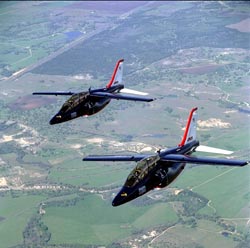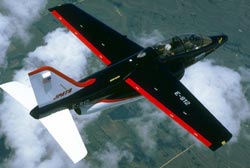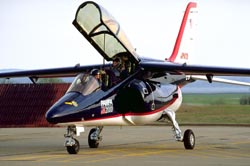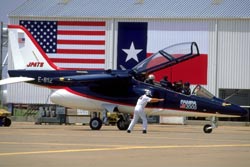|
 In 1990, LTV Aircraft Products made a decision to enter into competition for development and production of a next generation trainer airplane for the Air Force and Navy. The development program was required because both Air Force and Navy trainers were worn out after decades of service in the training of pilots. Announcement of the decision to initiate the program set off high-stakes competition among companies offering to build the trainer. The two services had decided to use the same trainer to replace the Navy’s T-34 turboprop and the Air Force’s T-37B jet trainer. The replacement program was called the Joint Primary Aircraft Training Program (JPATS). In 1990, LTV Aircraft Products made a decision to enter into competition for development and production of a next generation trainer airplane for the Air Force and Navy. The development program was required because both Air Force and Navy trainers were worn out after decades of service in the training of pilots. Announcement of the decision to initiate the program set off high-stakes competition among companies offering to build the trainer. The two services had decided to use the same trainer to replace the Navy’s T-34 turboprop and the Air Force’s T-37B jet trainer. The replacement program was called the Joint Primary Aircraft Training Program (JPATS).
The services specified they wanted an off-the-shelf aircraft already designed and ready to go. They did not specify that the aircraft had to be turboprop, turbojet or turbofan. After the Pentagon said it was all right for American companies to have an international partner on the project, LTV launched an intensive search before narrowing its list to 38 potential team members. LTV selected Fabrica Militar de Aviones, the Military Factory of Aircraft (FMA), at Cordoba, Argentina, as its partner. FMA had previously developed a high-winged jet trainer labeled as the IA63 with a tandem two-seat cockpit. The IA63 was powered by a Garrett turbofan engine, the TFE 731-2. This aircraft had just recently been placed in service in the Argentine Air Force as a trainer aircraft and had significant flying time.
 The IA63 was versatile as both a basic and intermediate trainer. It was designed for basic pilot skills, acrobatics, spin exercises, basic instrument flying, navigation, formation flying and in-flight emergency training exercises such as engine out exercises. On the intermediate end, the airplane could provide instrument training, low-level navigation training, formation flying, simulated tactical employment and tactical maneuvers. The IA63 was versatile as both a basic and intermediate trainer. It was designed for basic pilot skills, acrobatics, spin exercises, basic instrument flying, navigation, formation flying and in-flight emergency training exercises such as engine out exercises. On the intermediate end, the airplane could provide instrument training, low-level navigation training, formation flying, simulated tactical employment and tactical maneuvers.
Three IA63 aircraft were shipped to Dallas, Texas, and extensively modified to meet specific Pentagon requirements. Compliance with Military Specifications was investigated and, where necessary, modifications were implemented. A large engineering staff was employed, and the manufacturing factory was used to implement necessary changes to the aircraft. Fuel system modifications were made to meet stringent ground refueling requirements. The cockpit layout was dramatically changed, and additional avionics equipment and displays added. The AirResearch environmental control system was upgraded to meet U.S. specifications and requirements. Landing gear changes were implemented to meet stringent drop requirements. Pilot ejection systems were investigated for compliance. The changes implemented had no deleterious effects on proven flying quality characteristics.
 The entry into the competition was labeled the PAMPA 2000. Two of the refurbished aircraft were placed in a comprehensive Flight Test Evaluation Program. Argentine pilots were employed in the flight test program as well as two experienced LTV test pilots. The PAMPA 2000 was declared fully ready and the company committed and ready for submittal of a third Pampa 2000 aircraft which was fully missionized and compliant with all U.S. service requirements. The aircraft was shipped to Wright Patterson Air Force base in Dayton, Ohio, for extensive flight evaluation by Air Force and Navy pilots. The entry into the competition was labeled the PAMPA 2000. Two of the refurbished aircraft were placed in a comprehensive Flight Test Evaluation Program. Argentine pilots were employed in the flight test program as well as two experienced LTV test pilots. The PAMPA 2000 was declared fully ready and the company committed and ready for submittal of a third Pampa 2000 aircraft which was fully missionized and compliant with all U.S. service requirements. The aircraft was shipped to Wright Patterson Air Force base in Dayton, Ohio, for extensive flight evaluation by Air Force and Navy pilots.
Air Force and Navy pilots evaluated the flying characteristics of Vought’s Pampa 2000 jet trainer in August 1994.  The flight evaluation encompassed 10 days of rigorous testing. Vought provided a 16-member support team, but evaluation testing was solely accomplished by service personnel. Other government evaluators checked the maintenance aspects of the aircraft and evaluated a hot mockup of the Pampa 2000 cockpit. Fifteen sorties were accomplished in 6 days. The Pampa jet trainer was reported to have performed impressively. The flight evaluation encompassed 10 days of rigorous testing. Vought provided a 16-member support team, but evaluation testing was solely accomplished by service personnel. Other government evaluators checked the maintenance aspects of the aircraft and evaluated a hot mockup of the Pampa 2000 cockpit. Fifteen sorties were accomplished in 6 days. The Pampa jet trainer was reported to have performed impressively.
Vought, with the Pampa 2000, was the second competitor to participate in the flight evaluation. Seven contending aircraft were evaluated by Air Force/Navy personnel. These included:
- Vought Pampa 2000 Jet
- Grumman S211A Jet
- Rockwell Ranger 2000 Jet
- Cessna Citation Jet
- Northrop Grumman Super Tucano Turboprop
- Lockheed T-Bird 11 Jet
- Beech PC-9 Turboprop
Vought submitted a 10,000-page proposal to the government for producing the next-generation trainer aircraft for the Air Force and Navy. The proposal was considered to be top-notch, just like the airplane.
Vought’s entry in the JPATS competition, however, was not the winning entry.
|